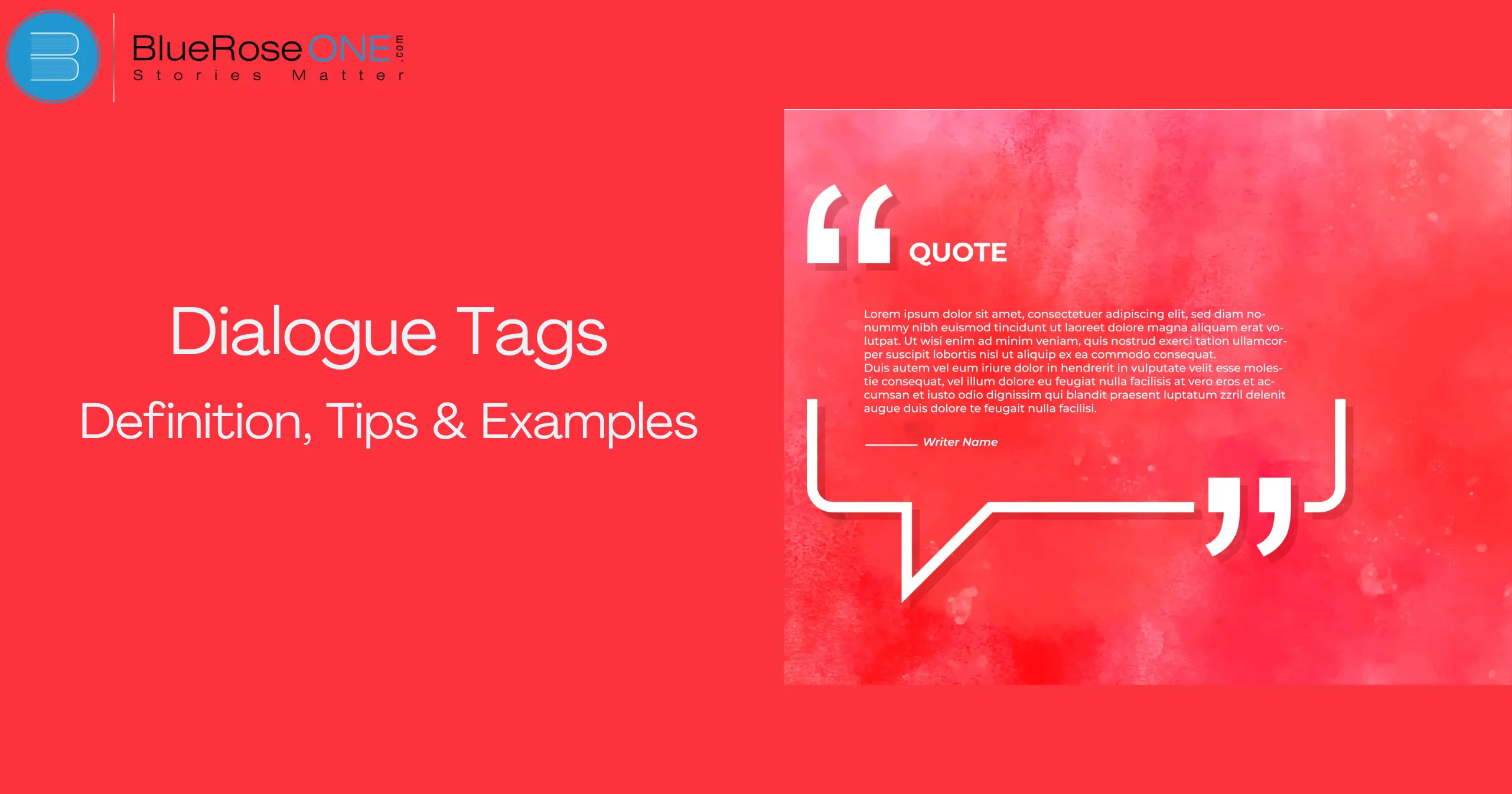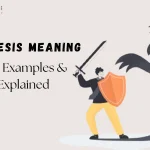Dialogue is an essential element of fiction writing that gives characters life and moves the story along. On the other hand, the readability and coherence of your story can be significantly affected by the speech you give each character. Here’s where dialogue tags are useful. This post will define dialogue tags, offer crucial advice for using them effectively, and provide examples to show how they might be used.
What Are Dialogue Tags?
Dialogue tags are terms used in written works to designate spoken words to a certain character. They are the “she asked” or “he said” that come after a character speaks to make it clear who is speaking. In order to guarantee that the reader can understand the discourse, certain tags are necessary.
Basic Structure of Dialogue Tags
A typical dialogue tag follows this structure:
- Dialogue + Comma + Quotation Marks + Dialogue Tag
Example:
“I’m going to the store,” she said.
Importance of Dialogue Tags
Clarity: Clarity is crucial when using dialogue tags in writing. Dialogue tags like “said” or “asked” help readers understand who is speaking, avoiding confusion. Without clear tags, conversations can become jumbled, making it hard to follow the story.
Proper use of dialogue tags ensures that each character’s speech is easily identifiable, maintaining the flow of the narrative and keeping the reader engaged. Effective dialogue tags are essential for clear and understandable storytelling.
Pacing: The use of dialogue tags is essential to a story’s pacing. They facilitate natural and interesting interactions by assisting in regulating their pace.
Writers can adjust the pace of exchanges, build tension, or ease the flow by judiciously using dialogue tags. When dialogue tags are used effectively, readers may follow along without being overtaken by detailed descriptions or perplexed by unclear language.
Characterization: In order to assist readers differentiate between various characters, dialogue tags are essential for characterization. Through the addition of tags such as “she yelled” or “he whispered,” authors can provide light on the feelings, character traits, and interpersonal dynamics of their characters.
Characters become more approachable and memorable when these tags are used to give depth and subtlety, rather than just identifying who is speaking. Simple interactions can be transformed into potent storytelling tools with the use of effective dialogue tags, which will increase the reader’s comprehension and engagement.
Tips for Using Dialogue Tags Effectively
1. Keep It Simple
Dialogue tags should be used as simply as possible. Use simple tags, such as “said” and “asked,” as these are inconspicuous and help the reader stay focused on the dialogue.
Steer clear of tags that are very intricate or detailed as they may detract from the conversation. Simple dialogue tags make the interaction in your writing clear and interesting for readers while also assisting you in maintaining a fluid and natural flow.
Example:
- “Are you coming with us?” he asked.
- “I’ll be there in a minute,” she said.
2. Use Tags Sparingly
When using dialogue tags, less is often more. Overusing tags like “said” or “asked” can make your writing feel repetitive and dull. Instead, let the dialogue and action convey who is speaking. For example, instead of “John said angrily,” you could write “John slammed his fist on the table.”
This method keeps the dialogue engaging and the pace of the story smooth, making your writing more dynamic and effective.
Example:
- “I can’t believe you did that!”
- “Believe it.”
3. Show, Don’t Tell
“Show, Don’t Tell” is a crucial tenet of good dialogue tag usage. Instead of tagging things like “he said angrily,” use the character’s words and actions to convey their fury. For instance, the phrase “he slammed his fist on the table” expresses rage more effectively.
By using this technique, you can improve the overall reading experience by making your writing more interesting and allowing readers to infer emotions and tones from the context.
Example:
- “I’m not sure this is a good idea.” She fidgeted with her necklace.
- He slammed his fist on the table. “We can’t let them win.”
4. Vary Your Tags
Change Up Your Tags: It’s critical to change up your conversation tags to maintain the interest of your readers. To express distinct emotions and tones, consider using other tags like “replied,” “asked,” or “shouted” in place of the word “said,” which is used a lot.
But be careful—using odd tags too frequently can become distracting. Changing up your tags adds energy and vitality to your speech while also fostering a compelling story.
Example:
- “Do you hear that?” she whispered.
- “Stop right there!” he shouted.
5. Placement Matters
The placement of conversation tags can have a big impact on how your writing flows. In general, tags assist keep the reader immersed when they are placed at natural pauses, such as the end of a dialogue or after the first sentence. She exclaimed, “It’s amazing! I can’t believe it!” as an example.
Because of this arrangement, readers may easily follow the discussion without being distracted. Well-positioned dialogue tags improve the readability of your work by making conversations understandable and interesting.
Example:
- “I’m not going,” she said.
- She said, “I’m not going.”
- “I’m not,” she said, “going.”
6. Avoid Overly Complex Tags
It’s crucial to steer clear of extremely complicated dialogue tags while utilizing them as they may detract from the discussion. It’s usually preferable to stick with simple tags like “said,” “asked,” or “replied” because they fit in with the text naturally. Complex tags that take undue emphasis away from the discourse itself are “interjected exasperatedly” and “exclaimed vehemently.” Tags should be kept basic so that readers are not distracted by them and may continue to concentrate on the characters and their dialogue.
Example:
- “It’s a disaster!” she exclaimed. (Better: “It’s a disaster!” she said.)
Examples of Dialogue Tags in Action
Let’s look at a few examples of dialogue tags used effectively in different scenarios:
Example 1: Simple Conversation
To correctly emphasize simple dialogue, use dialogue tags like “said” or “asked.” Using dialogue tags helps readers understand who is speaking in a conversation. Sam might have proposed, “Let’s go hiking this weekend,” for instance, in a story about friends planning a trip.
Sophie asked, “Do you know any good trails?” Here, the terms “said” and “asked” indicate when each speaker has the opportunity to speak. Readers are led through the discourse in an understandable and engaging way by employing these tags.
- “Did you finish the project?” John asked.
- “Yes, I sent it this morning,” Mary replied.
Example 2: Action Beats
Action beats are physical actions or gestures that characters perform during a conversation, often used in place of traditional dialogue tags like “said” or “asked.” For example, instead of writing “she said,” you might describe how she raised an eyebrow or clenched her fists.
These beats not only attribute dialogue but also add depth by revealing emotions and intentions through body language. They help to create a vivid and engaging scene where the characters’ actions speak as loudly as their words.
- “We need to leave now.” Sarah grabbed her coat and headed for the door.
- “Wait for me!” Tom shouted, running after her.
Example 3: Emotion Conveyance
Dialogue tags are essential for properly expressing the feelings and actions of characters in written works. Rather than just writing “she said,” authors frequently employ tags such as “she exclaimed,” “he muttered,” or “they whispered.”
These tags not only describe speech but also provide emotional background, illuminating the emotions or actions of the characters during speech.
By providing readers with a more vivid picture of the environment and the characters’ emotions, this strategy enhances narrative and gives readers a more realistic and engaging interaction.
“I can’t believe it’s over,” she whispered, tears streaming down her face.
“We’ll get through this,” he said, squeezing her hand.
Example 4: Varying Placement
When using “Dialogue Tags,” it might improve writing clarity and rhythm to change where they are placed within sentences. Writers can deliberately position tags like “he said” or “she asked” before, in the midst of, or even at the conclusion of sentences, as opposed to always inserting them immediately after dialogue.
This version smoothly incorporates dialogue tags into the discourse, keeping them from being annoying or repetitious. Writers can sustain reader interest and provide a natural cadence that enhances the dialogue by making placement adjustments.
“Are you coming with us?” Mark asked, glancing back.
Looking up from her book, Jane replied, “I’ll join you in a minute.”
“Alright,” he said, “but don’t take too long.”
Conclusion
A vital tool for authors, dialogue tags provide direction and facilitate the smooth flow of dialogue inside a story. You can improve your writing’s readability and engagement by adding action beats, utilising tags sparingly, keeping them basic, and changing where you put them.
If you follow these suggestions, your dialogue will flow more naturally and vividly, enhancing the lifelike quality of your characters and stories.
Remember, the goal of dialogue tags is to support your dialogue, not overshadow it. With thoughtful use, they can be an invaluable asset in your writing toolkit.
















